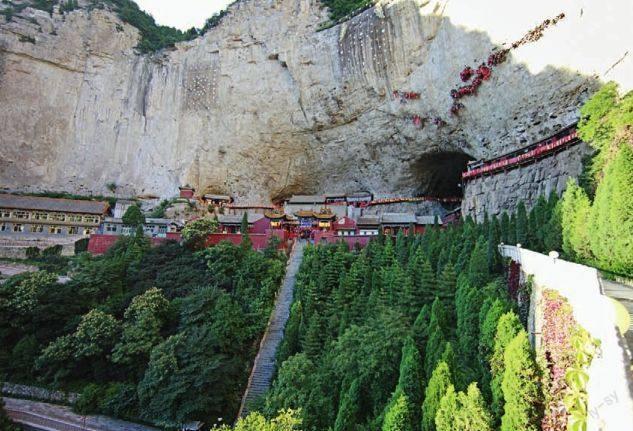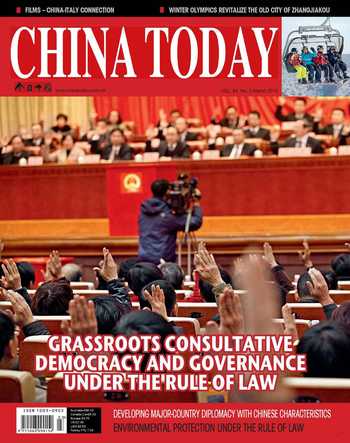Marvelous Mianshan
By staff reporter WANG SONG


LOCATED near the city of Jiexiu in North Chinas Shanxi Province, Mianshan Mountain is a famous cultural and historical site, the birthplace of the Cold Food Festival (Hanshi Festival) and the story of the loyal aide Jie Zitui. Its striking scenery leaves visitors with a sense of awe and a feeling that they have experienced something very special.
Origins of the Cold Food Festival
Chinese people have a unique concept of landscape aesthetics; famous mountains and great waters are usually inextricably linked with emi- nent historical figures. As the proverb goes, “Any mountain can be famous through the presence of a saint,” and this saying forms many Chinese peoples judgment criteria for grand mountains. Mianshan Mountain is also known as Mount Jie after Jie Zitui (year of birth unknown - 636 BC), an official of the State of Jin (1033-376 BC) renowned for his loyalty and filial piety, who lived in seclusion on the mountain.
Legend has it that during the Spring and Autumn Period (770-476 BC), the State of Jin was in turmoil and Prince Chonger (671-628 BC) was exiled. On one occassion, in order to sate the princes hunger, Jie Zitui, his advisor and personal friend, made him a meat broth. The prince drank the soup and felt revitalized, but wondered where Jie had managed to find the meat. It turned out that Jie had cut a piece of flesh from his own thigh. The prince was extremely moved by Jies loyalty and promised to reward him one day.
When Chonger succeeded the throne as the monarch of Jin, Jie resigned and went to live on the mountain with his mother. Appalled at the corruption he witnessed among his fellows, Jie lost all political ambition and became a recluse. When the monarch tried to find and reward him for saving him from starvation. Jie stayed hidden. At the suggestion of a treacherous court official, the monarch ordered fires to be set on the mountain to force Jie out of hiding. But the plan backfired and Jie and his mother were killed.
Filled with remorse, the monarch named the mountain after Jie and ordered that each year on the anniversary of his death, the lighting of fires be forbidden – all food was to be consumed cold. The Cold Food Festival was observed to commemorate him.
The Cold Food Festival (the 105th day after the Winter Solstice) was traditionally one or two days before the Qingming (Tomb Sweeping) Festival of the Chinese lunar calendar. Since it is so close to the Qingming Festival in early April, the two festivals are nowadays merged into one.
An Unusual Mountain
The peculiar Mianshan Mountain boasts more than 100 natural karst caves of different sizes. Among them, Baofu Cave (Belly-embracing Cave) is the largest, a huge grotto some 180 meters wide, 50 meters high and 60 meters deep. The cave houses over 200 halls and rooms of the Yunfeng (Cloudy Peak) Temple, which was built in ancient times to make the utmost of this magical natural gift, the giant and serene rock cave.
Yunfeng Temple enshrined and worshiped the King of Spirituality, the first Han Chinese to become a Buddha. Born in the Tang Dynasty (618-907), his secular name was Tian Zhichao and his body is incased in a clay statue in the center of the main hall. Tian is credited with bringing the Buddhist doctrine to the Mianshan Mountain region.
One of the Yunfeng Temple highlights is the auspicious bell hanging ceremony. This was originally a Buddhist memorial service to pray for rain and give thanks to Buddha during the Tang Dynasty, but it has evolved into a local folk custom. After making or redeeming a wish before the Buddha in the temple, people invite local professionals to hang jug-sized copper bells on the steep rock faces outside the cave.
Hanging the auspicious bells is a spectacular performance. First, the bell hanger climbs to the mountain top, ties a thick rope to a tree, and abseils down the mountain to the cliff face above the entrance of the cave. Another rope tied to his waist hangs down to the foot of the cliff, where his fellow swings the rope to help him move along the cliff side and affix the bells above the cave entrance. Afterwards, people set off fireworks to celebrate the auspicious ceremony. When breezes blow the tinkling of copper bells hanging on the cliff echoes throughout the valley.
In addition to Buddhist temples, Mianshan Mountain has a number of Taoist abbeys. Dailuo Palace is the grandest among them. With a floor space of some 30,000 square meters, the palace is more than 110 meters high, the equivalent of a 35-storey building.
Dailuo Temple features exquisite painted sculptures from the Tang to Qing (1644-1911) dynasties known as the “Dunhuang sculptures of Shanxi Province.” In addition, the palaces Scripture Hall houses 108 rosewood blocks engraved with the Tao Te Ching (a fundamental text in both philosophical and religious Taoism). These engravings are fashioned after the works of 108 contemporary calligraphers. Since some of these masters have passed away, Liu Haisu and Qi Gong among them, the engravings have become even more precious. Below these are 46 marble slabs inscribed with the Tao Te Ching in both English and Japanese, which are rarely seen in other places in China. Besides, the Depositary of Buddhist Texts on the temples top floor stores hundreds of rare books.
Dizzy Heights
With the highest peak at 2,566.6 meters above sea level, the main body of Mianshan Mountain is cut into two by the forces of nature. The relative altitude of this east-west mountain is more than 1,400 meters.
The mountain has a number of ancient plank roads. In ancient times, some of these pathways extended along the cliff face, while others cut through waterfalls. At times when the valley is shrouded in cloud and mist, a trip along these roads feels like walking on clouds. Tianqiao (Heaven Bridge) is the highest and most famous. Dating back more than 1,000 years, it stretches between two scenic spots; it is more than 300 meters long – but only one meter wide. Built on the cliff face behind an ancient military fortress, the road is some 80 meters from the cliff top and over 300 meters from the bottom.
Despite its dizzying heights and peculiar karst formations, Mianshan Mountain also exemplifies gentleness. Known as the place where Jie Zitui and his mother withdrew from society and lived in solitude, the winding Qixian Valley is well known for its jagged rocks in grotesque shapes and the babble of running water. Inside the zigzagging and secluded valley, visitors senses are heightened – they can see only a glint of sky above and hear only the nearby gurgling water. It is the perfect place to reflect on life.
The Guteng (Old Rattan) Valley is rich in flora,including vines, strange trees, wild fruits and valuable Chinese herbs. Some vines are 20 centimeters thick in diameter, hugging trees and crawling up the precipice. Moreover, the Shuitao (Torrents) Valley boasts dozens of waterfalls of different heights. Among them, Xiongshi (Lion) Waterfall sounds like the roar of a lion. But the most interesting is the Shuilian (Water Curtain) Cave, a natural cave three meters high and five meters wide. A screen of water covers the cave entrance. When they splash on the rocks, the water droplets resemble bouncing white pearls.
A Beautiful Combination
It can be said that the Mianshan region has lost some of its charm due to the new roads that were built to accommodate tourists. Cars whizz along the winding mountain roads, sometimes speeding through tunnels and sometimes taking a sudden turn. According to locals, in the past there were only unsurfaced, narrow trails for people to access the temples and pay their respects to Buddha. The roads around Mianshan are now wide enough for two coaches to pass one another safely. This is more convenient for tourists, who can be brought directly to the foot of the hill where Zhengguo Temple is located, for example. However, to reach the temple, visitors still have to climb hundreds of steps or they can pay RMB 15 to take a lift to the temple entrance.
Tourism developers built a 180-meter-high hidden lift inside the mountain. Visitors taking the lift for the first time will be amazed by its delicate design, which does not disrupt the harmony of the scenic spot, but enables travelers, especially the elderly and children, to go sightseeing, a perfect combination of modern engineering and traditional architecture.
Located on the hillside of Five Dragon Peak, Zhengguo Temple is unique in architectural form, consisting of two parallel halls for worshipping Buddhist relics and the clay-encased bodies of eminent monks and Taoist priests, as well as the Lingying Pagoda.
With the cliff as its backdrop, Lingying Pagoda was built during the reign of Emperor Taizong(598-649) of the Tang Dynasty. The 69-meter-high pagoda consists of seven floors above ground and two floors underground. It is a Mianshan Mountain landmark. Destroyed by Japanese invaders in 1940, it was rebuilt in 2003 as an octagonal Buddhist Pagoda according to its original design. Its inner space is compact, with two wooden ladders connecting two floors.
The illuminating, panoramic and peaceful view at the summit is reward enough for the steep climb. Wulongchan, or Five Dragons Traces, is named after the five dragons that, in folklore, following a sermon by the Buddha, took off into the sky, carving five gullies in the cliff.
The value of a scenic spot should not be judged by its tourist numbers, but by the spiritual worth and cultural experience it offers. Of course, accessibility to such places is of paramount importance in being able to reach such enlightenment, so the combination of the two – natural beauty and human practicality – as embodied by Mianshan, makes the mountain well worth a visit.

